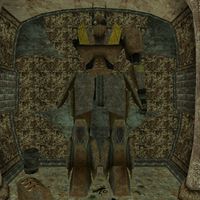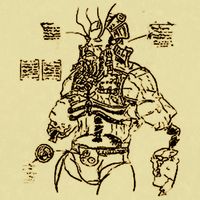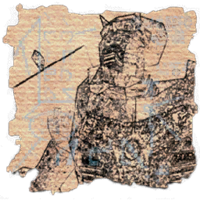Lore:Kagrenac
| High Craftlord Kagrenac | |||
|---|---|---|---|
| Race | Dwemer | Gender | Male |
| Died | 1E 700 Red Mountain |
||
| Resided in | Vvardenfell | ||
Lord Kagrenac (sometimes Kagrnak[1]), known as the Shop Foremer,[2] was the Dwemeri Chief Tonal Architect during the time of the First Council. The foremost arcane philosopher and mage-smith of the Dwemer, he was a "pioneer" in the field of mythopoeic forces, and devised tools with which to harness them with the intent of transcending the limits of Dwemer mortality.[3][4][5] Kagrenac was the primary architect working on the Heart of Lorkhan and was responsible for creating the original Brass God, Anumidium.[3][6] According to some theories, it may have been his use of his tools on the Heart that caused the Dwemer to disappear from the face of Tamriel in 1E 700.[3][7]
Contents
History[edit]
Kagrenac was known as a meticulous and careful planner.[3] He has been attributed with many titles over the years, among them "High Priest", "Magecrafter", and "High Engineer".[4][8] Master Crafter Yagrum Bagarn, the last living Dwemer, worked as one of Kagrenac's Tonal Architects and knew him personally, and he used "High Craftlord" as Kagrenac's proper title.[3][7] Vivec was inconsistent, calling him "High Engineer" and "Kagrenac the Blighter", though he also corroborated "High Craftlord", as well.[7][8][9] Kagrenac had numerous underlings; sources indicate Dahrk Mezalf and Bthuand Mzahnch (author of The Egg of Time) were just two other prominent smiths who worked under him.[3][10] Among their many amazing creations was Moon-and-Star, a specially enchanted ring that could only be worn by Nerevar, thus serving as absolute proof of their identity.[11]
Kagrenac's Plans[edit]
His theories on how to make a new god using the Heart of Lorkhan were explained in Divine Metaphysics, though the text remained indecipherable to anyone lacking detailed knowledge of Dwemeris. Yagrum Bagarn, though he did not work on the Anumidium project, was able to understand Kagrenac's theories, but refused to explain them, as he believed Kagrenac's theories should die along with him.[3]
As his alternate title "High Priest" suggests, Kagrenac was, for all intents and purposes, a religious leader in the little-understood Dwemer traditions. The precepts of Kagrenac were taught at the Dwemer settlement Kherakah, where it is said the most learned people in the world made their home. They spent their days studying Kagrenac's words and giving consideration to their place in the life to come. In Kherakah, nothing was more valued than the understanding of the self and its relationship to the Heart.[12] Kagrenac's library was found in a settlement known as Tureynulal.[13]
However, the Dwemer were not unified in their thinking about Kagrenac's theories. While Kagrenac and some of his architects emphasized the benefits, others believed that an attempt to apply his theories posed risks which were unjustifiable, noting the unpredictable side effects of his formulas and the potential for catastrophic error.[3][14]
The Cyrodiil historian Borgusilus Malier first theorized that in 1E 668, the powerful Dwemeri philosopher-sorcerer "Kagrnak" used the silent and magical ability of the Dwemer known as "the Calling" to gather his people together for a great, sublime journey, resulting in their disappearance.[1]
The Anumidium Project[edit]
At least one legend asserts that Kagrenac began acting on his theories in secret, implying that his subterfuge led directly to the War of the First Council. King Dumac, knowing nothing about his High Craftlord's project, denied its existence to his friend Nerevar, then took great offense when Nerevar returned later to demand their designs for the Heart of Lorkhan cease. The same legend says the High Craftlord was killed by Dagoth Ur during the Battle of Red Mountain, and it was Nerevar, with the aid of Azura, who turned the Dwemer to dust.[15] Vivec remained silent on whether Dumac knew of Kagrenac's project, but he does note that Kagrenac took great offense to Nerevar's assertions when the Hortator first questioned Dumac about it. He also notes that it was Dagoth Ur who, through unknown means, first discovered Kagrenac's plans for the Heart of Lorkhan and informed the Chimer leadership.[8]
Most accounts of the Battle of Red Mountain do not say that Dagoth Ur killed Kagrenac, but rather, that Kagrenac used his tools on the Heart at the climax of the battle, coinciding with the moment that all Dwemer then on Nirn disappeared.[3][4][7][8]
Creations[edit]
Kagrenac's Tools[edit]
Kagrenac's Tools are the legendary artifacts crafted by the Dwemer Tonal Architect Lord Kagrenac. Each tool served a specific purpose to siphon the power of the Heart of Lorkhan, via tonal manipulation of the laws of nature.
The gauntlet Wraithguard was created to safely wield the weapon tools, Sunder and Keening. Wielding the weapons without the gauntlet will often lead to the instant death of the wielder. Wraithguard also functions to empower the abilities of Keening and Sunder. Accounts of its appearance vary, but it typically looks like a gauntlet made of a material comparable to brass.
The hammer Sunder was created to produce a specific amount of power from the Heart. When struck by Sunder, the Heart would release godlike power.It is described as a hammer of divine mass.
The short blade Keening was created to flay and focus the power that the hammer Sunder produced. In song, it's described as a dagger made of the sound of the shadow of the moons.
Numidium[edit]
Numidium, also known as Anumidium, Anumidum, the Brass God, the Prime Gestalt, NM, the Brass Tower, Walk-Brass, Big Walker, Walking Star, and the Divine Skin, was a colossal construct of Dwemer origin. It was constructed by Dwemeri Tonal Architect Lord Kagrenac to be a new god, powered by the Heart of Lorkhan, made to retake Resdayn from the Chimer and possibly to make the Dwemer race immortal. The Dwemer vanished from Tamriel before the Brass God could be activated, though their disappearance may be directly related to this endeavor.
The Numidium was, in practice, a weapon of devastating power. A "thousand foot tall automaton, a golem or an atronach[nb 1] of sorts", it was used by Emperor Tiber Septim to complete his conquest of Tamriel at the end of the Second Era, but was destroyed afterward. The golem was rebuilt and reactivated centuries later, and became the center of the phenomenon known as the Warp in the West, after which it was destroyed again. Temporal distortions have accompanied each known use of the Numidium, to the point that the Warp in the West is sometimes known as the "Second Numidian Effect".
Some believe that the Numidium was intrinsically evil: a ranking Clockwork Apostle refered to it as the "most profane" of the Dwemer's creations, a "walking horror", the "Antipodal-God-Thing that reigned on the darkest pole of the sacred Nirn-Sphere", and the "welded knot at the center of Anu that must be untied". The Apostles considered the Numidium the greatest threat to Sotha Sil's goals of bringing about the Nirn-Ensuing and the Anuic convergence of Anuvanna'si. Indeed, in the Second Era, the Clockwork City's supervising Factotum, Aios, would name Numidium first among the existential threats to the City.
A second Numidium, Akulakhan, was partially constructed in Morrowind in the late Third Era by Dagoth Ur. However, the destruction of Kagrenac's enchantments on the Heart of Lorkhan in 3E 427 prevented its activation.
Notes[edit]
- In Dagoth Ur's Plans, it is noted that Dagoth Ur, who used a ritual of his own devising to bind himself to the Heart of Lorkhan, had apparently adopted the views and motivations of Kagrenac.
- 36 Lessons of Vivec, Sermon 36, contrary to every other source (even other works by Vivec), asserts that Kagrenac actually got his "walking star" Anumidium working at the Battle of Red Mountain. The great destruction it wrought created the Inner Sea, and it was only through the intervention of the Tribunal that it was defeated and the Dwemer were removed from the world.
See Also[edit]
- 36 Lessons of Vivec, Sermon 36 by Vivec — Book 36 of a series of words of wisdom relating to Vivec
- The Battle of Red Mountain by Vivec — The story of the Battle of Red Mountain and the Nerevarine Prophecies from Vivec's perspective
- Divine Metaphysics — An explanation of Anumidium's construction, written in Dwemeris
- Kagrenac's Tools by Gilvas Barelo — Concerning the use of Wraithguard, Keening, and Sunder at Red Mountain
- Nchunak's Fire and Faith by Nchunak — Nchunak's journey among the Dwemer and his attempts to understand the teachings of Kagrenac
- Nerevar at Red Mountain by the Tribunal Temple — A scholarly description of the events surrounding the Battle at Red Mountain and its aftermath
References[edit]
- ^ a b Chimarvamidium — Marobar Sul
- ^ People of Morrowind — Various
- ^ a b c d e f g h i Yagrum Bagarn's dialogue in Morrowind
- ^ a b c Kagrenac's Tools — Gilvas Barelo
- ^ Dagoth Ur's Plans — Tribunal Temple
- ^ Progress of Truth — Dissident Priests
- ^ a b c d Plan to Defeat Dagoth Ur — Vivec
- ^ a b c d The Battle of Red Mountain — Vivec
- ^ 36 Lessons of Vivec, Sermon 36 — Vivec
- ^ Events of Dahrk Mezalf in Morrowind
- ^ House Telvanni dialogue in Morrowind
- ^ Nchunak's Fire and Faith — Nchunak
- ^ Tureynulal in Morrowind
- ^ Baladas Demnevanni's dialogue in Morrowind
- ^ Nerevar at Red Mountain — the Tribunal Temple
| ||||||||||||||||||||||||||



